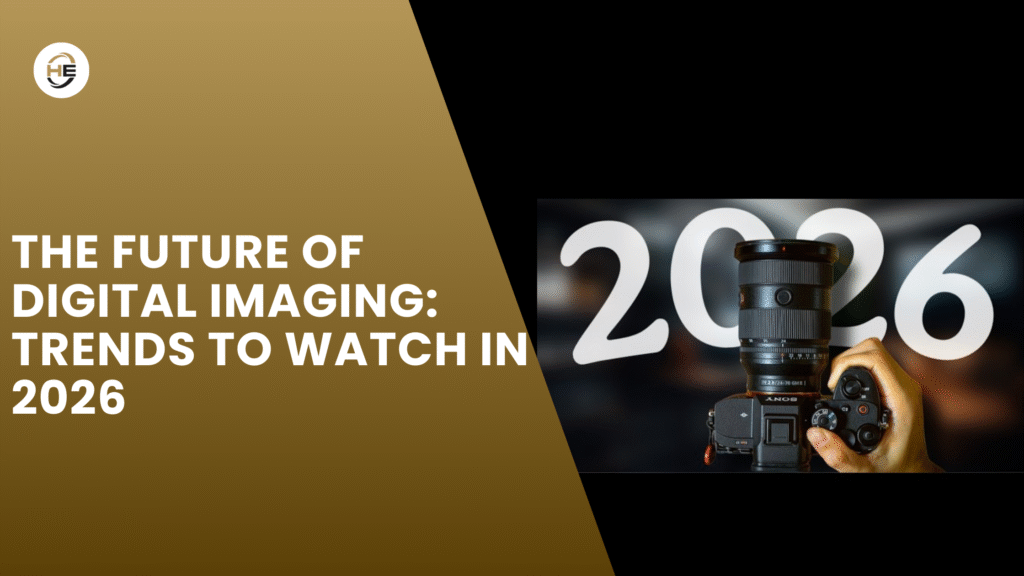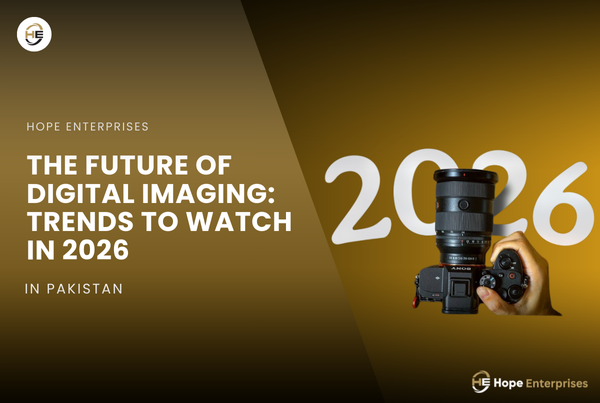
The future of digital imaging is quickly changing and introducing new possibilities and innovations in the world of photography and videography. Digital imaging will keep defining the way we produce, distribute, and use content in the year 2026. As new technologies are emerging, there is a likelihood of massive improvements in the domains of camera abilities, resolution and efficiency. These trends will not just change the professional industries; however, they will enable ordinary users to create high-quality content with little effort. The future of digital imaging is now brighter than it has ever been with AI-enabled photography and the widespread implementation of 8K and 12K video.
This article discusses the most significant changes in the near future. Finally, learning these trends is crucial to anyone in the creative space. The years ahead will define an essential change in the way we treat photography and videography. Now, we are going to take a look at the major trends and technologies that will shape this exciting new world.
The Evolution of Digital Imaging
Over the past few decades, digital imaging has undergone massive changes. The digitalization of film was only the starting point. We are currently experiencing cameras and software that are pushing the boundaries of what we thought was possible. The first digital cameras were large and could not give a high resolution, but today we have gadgets that can take high-resolution images and even videos in our hands. The incorporation of new state-of-the-art sensors, superior lenses, and more intelligent software has made the quality of digital imagery much higher. Consequently, digital imaging is even more transformative in nature and is set to bring radical changes to the industry in the future.
Major Digital Imaging Trends to Watch in 2026
In the future, the digital imaging industry will undergo a number of trends that will change the way things are in 2026. They are the emergence of AI-based photography, the common use of ultra-high-definition video, and the trend towards smaller but more powerful equipment. Even such innovations as the creation of 360-degree content or sustainable manufacturing influence the process of digital media thinking. We will now explore these interesting trends that are going to revolutionize the future of digital imaging.
Trend 1: AI and Computational Photography
The future of digital imaging deals with artificial intelligence (AI) and advanced imaging technology. Such technologies allow cameras to make automatic improvements, sharpen, and even create breathtaking effects automatically. AI can interpret scenes and rearrange the settings to create the best exposure, colour, and detail. This means both professionals and hobbyists can easily take outstanding shots. In the short term, AI will further simplify the photography process by adding features like automatic editing, better low-light performance, and seamless integration with other digital applications.
Trend 2: 8K & 12K Video Becomes Mainstream
Increasing 8K and 12K video resolution is another important trend in the future of digital imaging. These high-definition formats are going higher. It is now possible to record amazingly sharp images with a modern camera that is worth showing on a big screen and provides an immersive experience. By 2026, 8K, 12K video is expected to be the new standard used by professional filmmakers, content creators and even ordinary users who desire to create a cinematic quality video. These developments are likely to bring the visual narrative to greater heights.
Trend 3: 360° and Immersive Content Creation
With virtual reality (VR) and augmented reality (AR) gaining momentum, the creation of 360-degree and immersive content is bound to become even more significant. In 2026, it will be possible to have a higher number of cameras that can capture VR and AR content, which will enable creators to produce complete experiences. This will have an impact not only on the entertainment industry but on other sectors such as education, real estate and tourism. Digital imaging in the future will be about producing content that encompasses the viewer and provides an experience never seen before.
Trend 4: Compact Yet Powerful Gear
There will be smaller, more powerful devices in the future of digital imaging. Due to technological growth, manufacturers are coming up with cameras and equipment that have a lot of performance contained in a smaller, more portable unit. This trend especially attracts content creators who require quality tools but do not want to carry bulky equipment. The trend in 2026 will be compact devices such as drones, mirrorless and action cameras that will be the preferred tool by most photographers and videographers.
Trend 5: Sustainability and Eco-Friendly Manufacturing
The future of digital imaging is turning out to be more sustainable. With the increasing environmental consequences of technology, manufacturing companies are orienting towards eco-friendly production processes. The increase in more energy-efficient gadgets and a rise in the use of recycled materials can be expected. It will also have a more significant push towards the minimization of electronic waste. There is a growing demand for consumers towards sustainable products, and the digital imaging companies must find ways to meet the evolving demands. In 2026, there are high chances of a significant change in the industry to embrace a greener way of manufacturing.
Emerging Technologies Revolutionizing Imaging
Besides the above-mentioned trends, there are also other emerging technologies that are bound to transform the future of digital imaging. This will increase cloud-based photo and video editing with the introduction of innovations such as 5G, which has a higher speed of data transfer. Likewise, the advances in optics and sensor technology will see even more improvement in low-light performance and autofocus speed. The post-production will be easier and efficient with advanced algorithms of image processing, which will be enhanced by AI. Consequently, content makers will have an opportunity to create high-quality works even more quickly than they used to.
Impact on Photographers & Videographers
Digital imaging will influence photographers and videographers in a significant manner. Creators will be able to push the limits of their craft with more powerful and intelligent tools at their disposal. The editing process and real-time improvements with the help of AI will simplify workflow, and the possibilities of storytelling with the help of ultra-high-quality video and immersive content will be revealed. The availability of innovative equipment, such as portable devices and environmentally friendly gadgets, will open the industry to new talents. Altogether, digital imaging will help creators to create beautiful pieces without putting much effort and with higher accuracy.
The Role of Pakistan’s Imaging Industry
The imaging business in Pakistan has big potential in the years to come. Companies such as Hope Enterprises are also taking a crucial role by offering internationally renowned audio, video and digital imaging products to local content makers. Since 1995, Hope Enterprises has empowered photographers and videographers to achieve their potential by providing them with state-of-the-art equipment from highly acclaimed international brands. The company will carry on with its legacy in the future by providing new advanced technologies that would allow Pakistani content creators to remain at the forefront. With the future of digital imaging taking shape, Pakistan’s contribution to the world imaging market will still gain more prominence.
What the Next Generation of Cameras Might Look Like
Digital imaging is expected to have even smarter, more powerful, and easier-to-operate cameras in the future. In 2026, we will likely see AI-enabled cameras, which user-adjust the camera settings depending on the scene and subject. Such devices can also be integrated with cloud services. It will enable creators to edit and share content simultaneously. Also, the future generation of cameras will probably be smaller and lighter. They will have the ability to take ultra-high definition photos and videos. The opportunities for content creation will be infinite.
As we look to the future of digital imaging, the opportunities for content creators are exciting. The digital imaging industry will experience an enormous change, with AI-enhanced photography or immersive 360 video. Such trends do not just define the way we frame the world around us but also the way we share and experience it. The next few years are going to be an exciting period in digital imaging, and keeping up with these trends will be the main success factor in this field, which is constantly changing.
FAQS
AI-based imaging is the largest trend of 2026. The cameras will automatically change the lighting, focus, and composition to produce flawless results. It will ease the processes of work, accelerate the editing process, and enable professionals and beginners to create studio-quality images with ease.
Digital imaging products will likely have an 8K video as a new video standard in 2026. It will work with a variety of cameras and smartphones, and can show more detailed images, richer colours, and crop or edit better quality images.
Pakistani creators will benefit from faster, smarter, and more affordable imaging tools. With advanced AI cameras and 8K support, they can produce world-class content locally, attract global clients, and compete in international photography and filmmaking markets more effectively.




